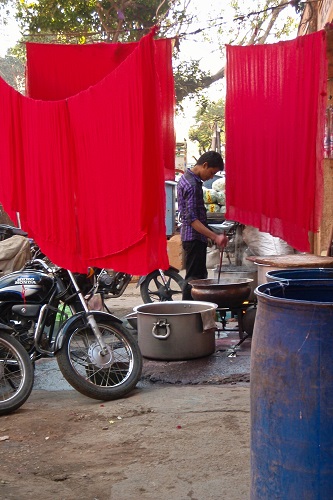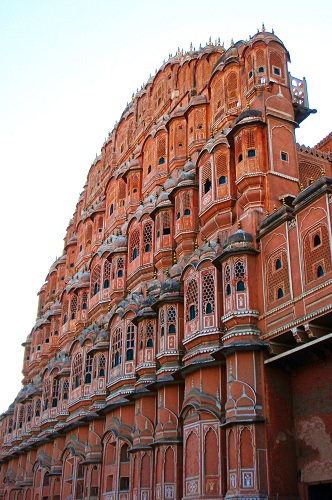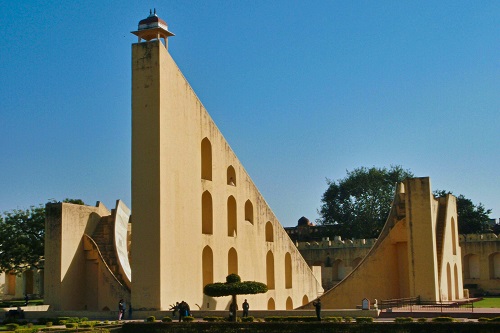As the lid was lifted off the basket, the snake's head wove upwards. Its beady unblinking eyes were cautiously alert, its hood flaring out in a defensive display. The head continued to weave in time with the haunting tones of the pungi, a curious wind instrument made from a gourd. The snake charmer was clad in a bright orange shirt with equally garish material coiled around his head in a photogenic turban. He lifted the venomous snake from its basket and proceeded to wrap it around his neck. We thought this was quite a daring stunt until he confided in us that the cobra was in fact completely harmless. Snake charmers were just one of many interesting things we came across in Jaipur's Pink City.
Jaipur is the capital of Rajasthan and part of the Golden Triangle, a popular tourist route linking the city with Delhi and Agra. Founded in 1726 by Maharajah Jai Singh II, who gave his name to the new development, Jaipur is now best known as the Pink City. This actually just refers to the historic walled city, painted pink to honour the Prince of Wales visiting in 1876. Although the old town retains its characteristic colour, it's definitely more terracotta than pink. The Pink City is the focus of most tourists' itineraries, however the hills around Jaipur also offer some interesting distractions.
Shopping In Jaipur's Pink City
Entering the Pink City, we passed through a triple arched gate, covered in swirling designs and leafy plant motifs. The Pink City is renowned for its shopping opportunities with the shops carefully divided into distinct areas. We saw rows of shops full of bangles with no other jewellery in sight. In another area, neat piles of spices filled every store, one with so many overflowing sacks of chillies that it made us cough and sneeze as we walked by. The shopkeeper however, seemed completely unaffected. On the street of repair shops we saw mechanics up to their elbows in grease surrounded by dismantled vehicles and piles of spare parts. Meanwhile, steaming cauldrons of dye were carefully tended outside a row of textile shops.

Dyeing Cloth
“Can I ask you a question?” is an opening line we heard a lot. It's hard to say no to this so every time we ended up engaged in conversation. The next question was invariably “Why won't foreigners stop and talk to us?” The obvious answer is because any friendly chat inevitably ends with a sales pitch. After insisting this was definitely not their intention, we would always be invited to peruse their wares.

Giant Silver Urn
The City Palace, Heart Of The Pink City
A cluster of buildings, each with scalloped arches and intricately carved marble screens, forms the City Palace. Most of the buildings house museum collections including a display of previous Maharajahs' clothing and an armoury. In the central pavilion, we found two enormous urns that are the largest silver objects in the world. In the early 1900s, the Maharajah used the urns to bring water from the Ganges with him to London. Given modern day hygiene standards, it seems odd that he felt the Indian river water was safer to drink than London's tap water.
The highlight of the City Palace for us was Pritam Chowk. This courtyard had four elaborate gateways, each representing a different season. A small statue of a Hindu deity sat above each of the brass doors. Most impressive was the autumn gate where Vishnu sits surrounded by royal blue peacocks, their tails fanned out around the arch. From the courtyard, we had a clear view of the palace where the Rajasthani royal family still live. It was huge and ornate but the yellow walls weren't really in keeping with the rest of the Pink City.

Gateway At Pritam Chowk
Hawa Mahal
Nearby, we found the Hawa Mahal or Palace of Winds. Each of the 5 storeys was adorned with tiny windows, jali screens and layered domes. It is just an elaborate facade but this was intentional. It was built so the ladies of the palace could watch what was happening in the street below without being seen. Inside we enjoyed seeing the stained glass windows bathing the rooms in a rainbow of colour. We also ended up at the centre of a class photo with a school group. This happened a lot in India. At nearly every tourist attraction we visited somebody would ask to have their photo taken with us.

Hawa Mahal
Jantar Mantar
Jantar Mantar is a bizarre collection of gigantic astronomical measuring devices. It's the largest of four identically named observatories in India. The garden is filled with sundials and other instruments designed to measure the exact positions of celestial bodies. The most impressive for us, probably due to its size, was the Samrat Yantra. This 27-metre tall wedge, complete with decorative arches and a dome, rests across a semicircular base. It forms an unusual but extremely accurate sundial.

Sundial At Jantar Mantar
Where To Eat In Jaipur
Uninspired by food in the Pink City we left through the Ajmeri Gate and head west along MI Road. We found several decent restaurants interspersed with the ever popular lassiwalas, specialising in lassi, a refreshing yoghurt-based drink. Some are made with ice, which is worth avoiding if you want to stay healthy in India. Be sure to check before ordering. We ate at a few restaurants along this road but our favourite was Mohan's Classic Restaurant behind Ganpati Plaza shopping centre. They serve vegetarian meals and reassuringly large naan. Their Dum Aloo Kashmiri, potato stuffed with Indian cheese and smothered in a spicy tomato sauce was particularly good.
The locals we met in Jaipur were a very mixed bag. Standing on the kerb studying several lanes of tuk tuks, carts and camels we were joined by a friendly old man. He happily chatted to us, lamenting about the difficulty of crossing the road as we achieved this daunting task together. On the other hand we met a group of young kids who shouted “Hello! Give us chocolate.” When we refused, one punched Chris, in a very childish manner, before they ran off. Despite the variable encounters with the locals, the historic centre of Jaipur is packed with interesting sights, sounds, smells and even the odd snake charmer.
